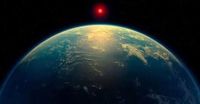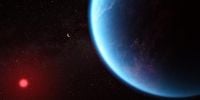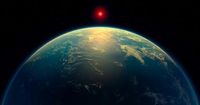A distant world unlike any planet in our Solar System could potentially be teeming with life, according to a groundbreaking new study. “We found the strongest evidence to date of possible biological activity on an exoplanet,” University of Cambridge Prof. Nikku Madhusudhan said in a video announcement. Madhusudhan and his team used data from the James Webb Space Telescope to find chemical signatures they believe suggest life on K2-18b. That’s a planet about two and a half times the size of Earth, and 8.6 times more massive, that sits in the habitable “Goldilocks Zone” of a dwarf star about 120 light years away.
Researchers specifically searched for a chemical called dimethyl sulfide (DMS), which on Earth is produced solely by living organisms such as algae. It’s so uniquely produced by life that scientists have theorized that checking other planets for its “biosignature” could be the key to finding life outside our own planet. And that’s what they’ve found, as well as another potential marker of life called dimethyl disulfide (DMDS), and in levels thousands of times higher than what’s seen on Earth, according to research published in The Astrophysical Journal Letters.
“Given everything we know about this planet, a Hycean world with an ocean that is teeming with life is the scenario that best fits the data we have,” Madhusudhan stated in a press release from Cambridge. However, he also called for caution, emphasizing that more research is needed. “We should remain open-minded and get more observations so we can repeat this signal. That’s the hallmark of science, the repeatability and increase in robustness till we get, till we are really, really satisfied,” he added. “We are not there yet.”
Madhusudhan explained that while DMS and DMDS are believed to be markers of life, there’s always the possibility that they might exist on worlds such as K2-18b via processes not yet known to us. Other researchers echoed his sentiments, stating it will take time and more study before anyone can confidently claim this planet is a candidate for life outside of Earth. “We should be cautious. I want that to be front and center,” Måns Holmberg of the Space Telescope Science Institute, who was part of the group announcing the findings, told NPR. “Any claim of life on another planet requires a lot of justification, and I don’t think we’re there yet.”
Stephen Schmidt, a planetary scientist at Johns Hopkins University, told the New York Times that the new study offered a “hint.” “But we cannot conclude it’s habitable yet,” he cautioned. Christopher Glein, principal scientist at the Space Science Division of the Southwest Research Institute in Texas, described the new study as making K2-18b a “tantalizing world.” “Yet, we must be very careful to test the data as thoroughly as possible,” he remarked. “I look forward to seeing additional, independent work on the data analysis starting as soon as next week.”
Another scientist is even more skeptical: Dr. Nicolas Wogan of the NASA Ames Research Center has published a paper suggesting the planet has no habitable surface at all but is rather a mini gas giant, the BBC noted. Despite these differing opinions, Madhusudhan is determined to clarify the situation. “This is the strongest evidence yet there is possibly life out there,” he told the BBC. “I can realistically say that we can confirm this signal within one to two years.”
In a separate announcement, researchers noted that K2-18b is more than eight times the mass of Earth and 2.5 times as big. It orbits its star in a habitable zone, also known as the “Goldilocks zone,” where conditions are favorable for liquid water—a key ingredient for life. Since the 1990s, about 5,800 exoplanets have been discovered beyond our solar system, and scientists have pointed to the possibility of Hycean worlds, which are covered with liquid water oceans and might be habitable by microorganisms.
Madhusudhan stated, “If Hycean worlds existed, we are talking about microbial life, possibly like what we see in the Earth's oceans.” However, when asked about the potential for multicellular organisms or even intelligent life, he admitted, “We won't be able to answer this question at this stage. The baseline assumption is of simple microbial life.”
Despite the excitement surrounding these findings, skepticism remains prevalent in the scientific community. Astronomers announced on April 17, 2025, that they had detected the most promising hints of potential life on K2-18b. There has been vigorous debate about whether this planet, located 124 light years away in the Leo constellation, could be an ocean world capable of hosting microbial life.
The researchers emphasized the need for caution, stating that more observations are required to confirm their findings, and they are not announcing a definitive discovery. “What we are finding at this point are hints of possible biological activity outside the solar system,” Madhusudhan explained during a press conference. “Frankly, I think this is the closest we have come to seeing a feature that we can attribute to life.”
However, outside experts have pointed to disputes over previous discoveries regarding K2-18b, arguing that these chemicals could have been created by unknown means unrelated to life. K2-18b has long been considered a premier candidate for Hycean planets—ocean worlds bigger than Earth with hydrogen-rich atmospheres. While these planets are not expected to host intelligent alien life, they could harbor tiny microbes similar to those found in Earth's oceans billions of years ago.
Some research has suggested that currently proposed Hycean planets, including K2-18b, might be too close to their stars to support liquid water. Raymond Pierrehumbert, a planetary physics professor at Oxford University, has indicated that K2-18b is too hot for life. If the planet did have water, it would be “hellishly hot” and uninhabitable, he stated, adding that oceans of lava were more plausible.
As scientists continue to explore the potential for life beyond Earth, Madhusudhan estimated that it would take just 16 to 24 more hours of Webb's time to confirm their findings, which could happen in the next few years. Even beyond K2-18b, he believes that Webb and future telescopes could allow humanity to discover life outside our home planet sooner than one might think. “This could be the tipping point, where suddenly the fundamental question of whether we're alone in the universe is one we're capable of answering,” he said.






